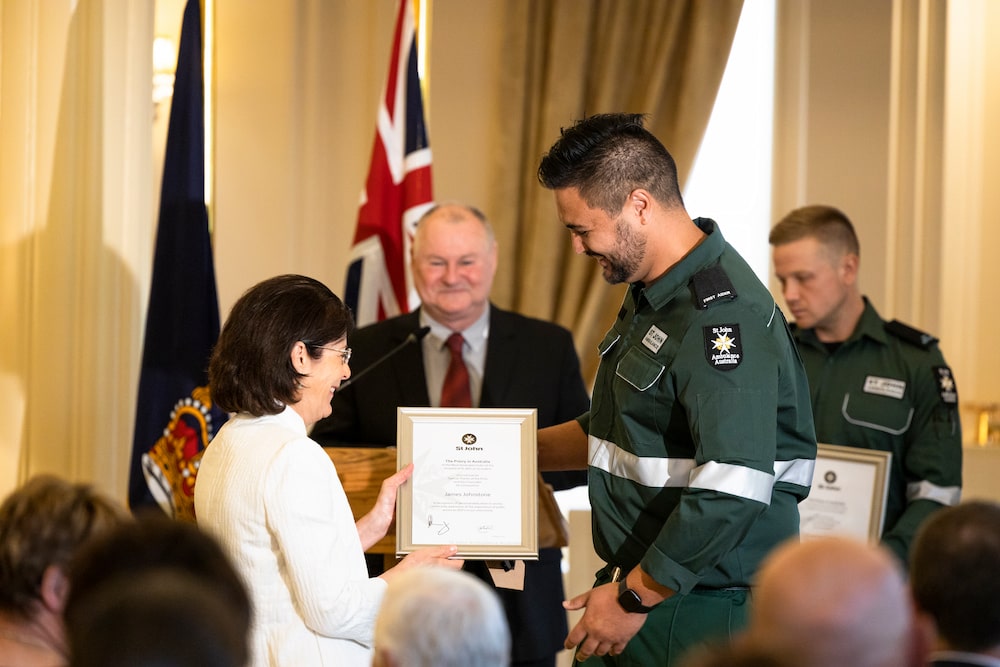When Jay Johnstone suffered sudden onset cardiac arrest at the gym as a 30-year-old, he was lucky to be in the same room as someone with the confidence to perform CPR and use an automated external defibrillator (AED).
“All of a sudden I felt shortness of breath, weight on my chest, and I was spinning out of control,” Mr Johnstone said.

St John Ambulance volunteer Tom Cressy initially thought his gym buddy was having an asthma attack when he saw him struggling, but when Mr Johnstone curled in the recovery position he realised it was something far more serious.
Mr Cressy followed his training; he checked vital signs and airways, he told onlookers to call an ambulance and find an automated external defibrillator (AED), then he began CPR.
To his horror, the gym didn’t have an AED and, without one, it was unlikely Mr Johnstone would survive.
For every minute that passes, there is approximately a 10% reduction in survival from sudden onset cardiac arrest.
Ten minutes without an AED means a five to 10% chance of survival, and Mr Cressy was informed the ambulance was 13 minutes away.
Although he had attended every training he possibly could, nothing could prepare him for the experience of performing CPR to save a life.
“When you come across a patient in training, it’s a legless, armless dummy,” he said.
“And they say, ‘This person is unconscious, they’re not breathing’.
“They won’t tell you that a person will go from talking to you to dead in 20 seconds, and it will happen in an instant.”
Mr Johnstone’s partner watched in tears, music blared in the background and a crowd of onlookers gathered as Mr Cressy concentrated on his task.
“They won’t tell you that you will feel the ribs break, that people will make weird noises when you give them CPR, and that CPR is one of the most taxing things you can do.”
Thankfully, a gym patron guessed correctly that a nearby Woolworths supermarket would have an AED, and returned with the crucial device within seven minutes.
“We shocked Jay. And Jay’s not a small guy; but it was one of the most violent things I’ve ever seen.”
Once he had an AED in his hands, and amazed by its strength, Mr Cressy felt sure Mr Johnstone would survive – which he did.
“We know [AEDs] save lives. CPR can only do so much, and the defibrillator needs to shock the heart, you need to get the rhythm back.”

Mr Cressy’s advice to people who find themselves bystanders to a crisis is simple: push past the terror, act quickly and confidently.
Sudden cardiac arrest claims 30,000 Australian lives each year, a figure St John Ambulance Australia CEO Len Fiori is determined to see go down by increasing bystander use of defibrillators to 50% nationwide by 2025.
Speaking at the launch of a new St John AED at Government House in Yarralumla yesterday, 10 March, Mr Fiori said statistics showed up to 80% of sudden onset cardiac arrest patients would survive if given CPR and early defibrillation.
The self-funded charity’s mission was supported by Governor-General David Hurley and Linda Hurley, who gifted 10 Australian not-for-profit organisations a St John AED.
The Country Women’s Association of Australia, Volunteering Australia, Mission Australia, National Rural Health Alliance, Solider On, Australian Men’s Shed Association, Bridging the Gap, FORTEM Australia, People with Disabilities Australia and YMCA Canberra received an AED to share with their communities.
Australian Men’s Shed Association chairman Paul Sladdin said the AED he was honoured to accept would most likely go to a rural shed, where it may be used by the wider community.
The Governor-General, who is also Prior of the Order of St John, said sudden cardiac arrest was a risk factor for everybody.
He lost a good friend who died at a golf course because there was no AED available.
“So, we can reduce the risk by putting these into training facilities like gyms, into shopping centres, into our offices spaces, throughout our community,” he said.

“Know where they are, give the people the training so they’ve got the confidence to use them, and be ready to use them the moment it occurs.
“And it could occur at any time.”
The trauma Mr Johnstone experienced crystallised his appreciation of the present and inspired him to help others.
The young cardiac arrest survivor joined St John Ambulance ACT as a volunteer, working alongside Mr Cressy to “pay off this life debt”.
He quit his job in IT and started a new career in disability care.
“Coming from my own cardiac recovery, I help other people through their own recoveries, through their own stories,” he said.
Mr Johnstone’s choices reflect the St John mission, to help people in sickness, distress, suffering or danger.
“I really appreciate every minute of my life because I know, statistically, I shouldn’t be here.”
On behalf of the St John Priory in Australia, the Governor-General awarded Mr Johnstone and Mr Cressy special thanks of the Prior and Chancellor in recognition of their dedication in raising community awareness of the importance of public access to AEDs.
For more news:



